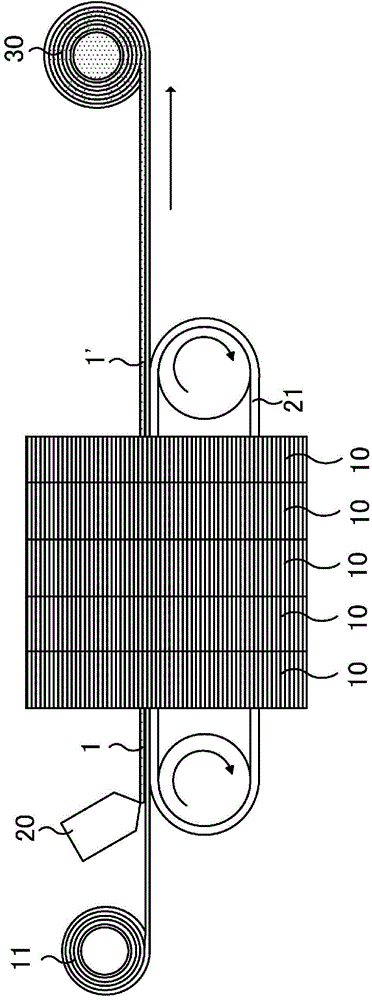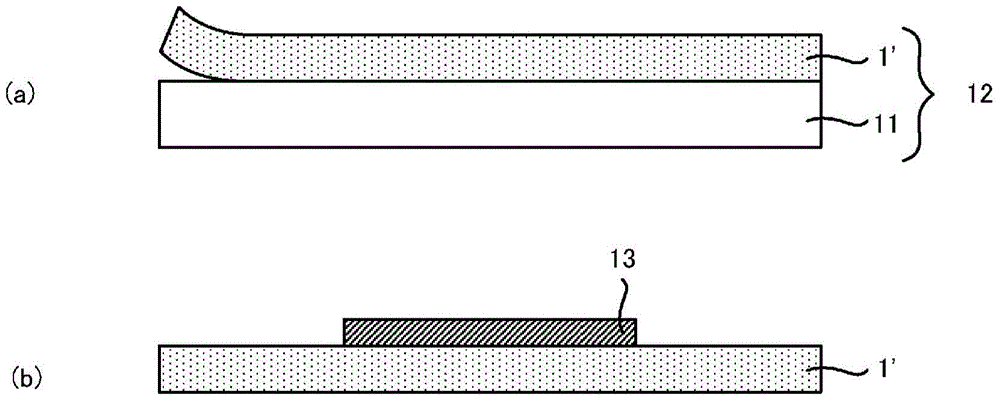Transparent polyimide laminate and manufacturing method therefor
A transparent polyimide and polyimide layer technology, applied in chemical instruments and methods, layered products, synthetic resin layered products, etc., can solve the problem of low light transmittance and difficult application of polyimide film Flexible display panel substrates and other issues, achieve the effects of small in-plane retardation, easy peeling, and high light transmittance
- Summary
- Abstract
- Description
- Claims
- Application Information
AI Technical Summary
Problems solved by technology
Method used
Image
Examples
preparation example Construction
[0145] 3-5. Preparation method of solution containing polyimide precursor
[0146] The solution containing a polyimide precursor is obtained by making the said tetracarboxylic-acid component (A) and the said diamine component (B) react in the said solvent. When the number of moles of the diamine component (B) in the solvent is x and the number of moles of the tetracarboxylic acid component (A) is y, y / x is preferably 0.9 to 1.1, more preferably 0.95 to 1.05 , more preferably 0.97 to 1.03, particularly preferably 0.99 to 1.01. By polymerizing a tetracarboxylic-acid component (A) and a diamine component (B) at such a ratio, the molecular weight (polymerization degree) of a polyimide precursor can be adjusted suitably.
[0147] The order of polymerization reactions is not particularly limited. For example, first, a container equipped with a stirrer and a nitrogen gas introduction tube is prepared. The solvent mentioned later was injected|thrown-in in the container which replac...
Embodiment
[0175] Hereinafter, the present invention will be described in more detail through examples. However, the scope of the present invention is not limited by these Examples in any way. In Examples and Comparative Examples, the following methods were used to measure peel strength, imidization rate, residual amount of solvent, glass transition temperature, total light transmittance, haze, and L*a*b colorimetric system. b-value, in-plane retardation, and ten-point average roughness of the supporting substrate.
[0176] 1) Peel strength
[0177] The transparent polyimide laminated body produced in the Example and the comparative example was cut out to length 50mm, and width 3.5mm. The peel strength of this transparent polyimide laminate was measured according to the method prescribed|regulated by JIS C-6471. Specifically, the short edge of the transparent polyimide laminate was held, and peeled from the support base material at a peeling angle of 90° and a peeling speed of 50 mm / m...
Synthetic example 1
[0207] 469.4 g (3.3 moles) of 14BAC and 5761 g of DMAc were added to a 300 mL five-necked separable flask equipped with a thermometer, a stirrer, and a nitrogen gas introduction tube, and stirred. 970.9 g (3.3 mol) of powdery BPDA was added to this liquid mixture. After adding BPDA, the reaction vessel was placed in an oil bath maintained at 120°C for 5 minutes. The salt precipitated out about 3 minutes after the addition of BPDA, but dissolved rapidly thereafter. This mixed solution was further stirred at room temperature for 18 hours to obtain a solution containing a polyimide precursor.
PUM
| Property | Measurement | Unit |
|---|---|---|
| Glass transition temperature | aaaaa | aaaaa |
| Thickness | aaaaa | aaaaa |
| Peel strength | aaaaa | aaaaa |
Abstract
Description
Claims
Application Information
 Login to View More
Login to View More - Generate Ideas
- Intellectual Property
- Life Sciences
- Materials
- Tech Scout
- Unparalleled Data Quality
- Higher Quality Content
- 60% Fewer Hallucinations
Browse by: Latest US Patents, China's latest patents, Technical Efficacy Thesaurus, Application Domain, Technology Topic, Popular Technical Reports.
© 2025 PatSnap. All rights reserved.Legal|Privacy policy|Modern Slavery Act Transparency Statement|Sitemap|About US| Contact US: help@patsnap.com



